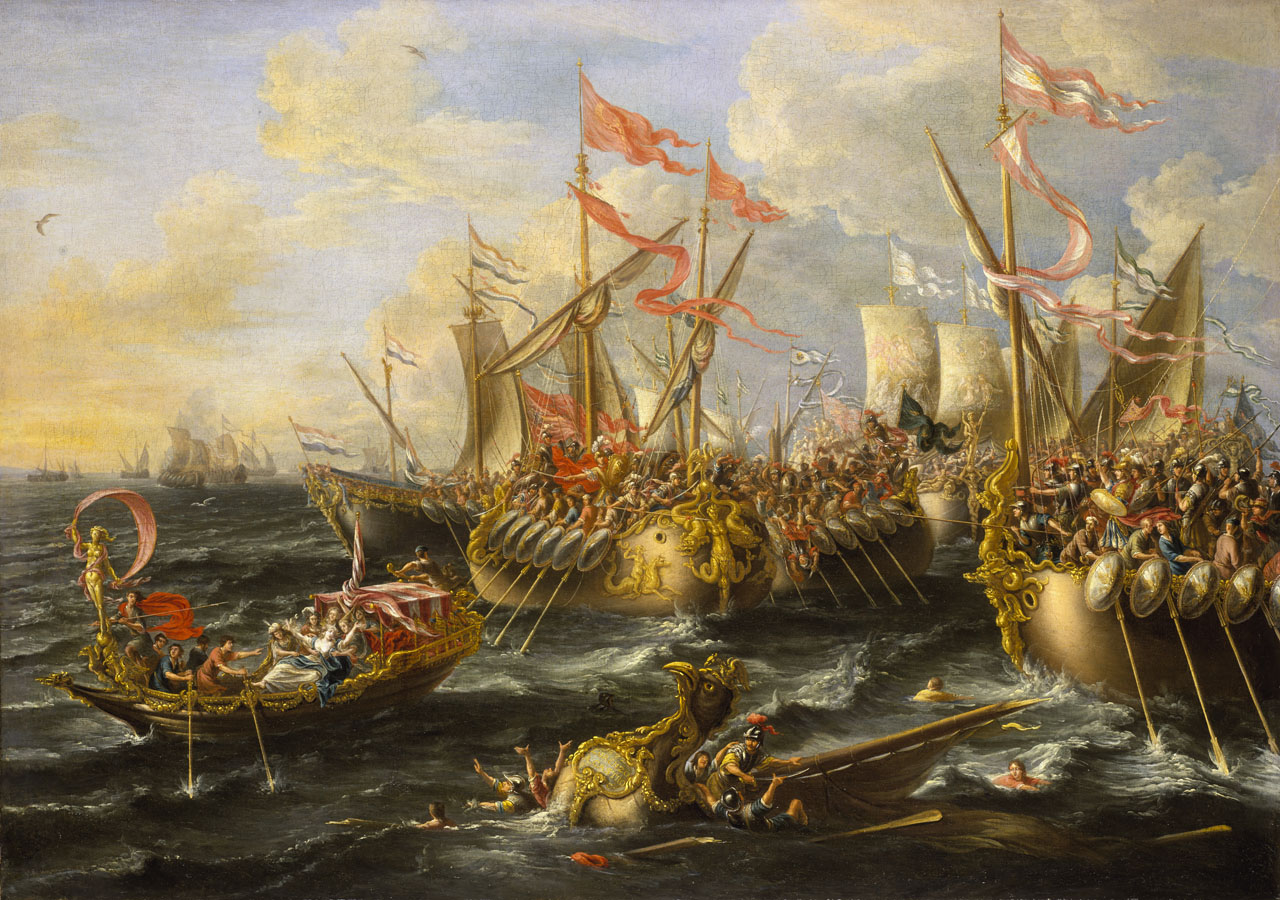The Romans entered naval warfare relatively late compared to their achievements on land. After securing a vast territory in Italy and defeating their last significant nearby threat, the Samnites, they became embroiled in a bitter conflict with the Carthaginians. By then, Carthage was the dominant naval power in the western Mediterranean, while the eastern Mediterranean was controlled by the fleets of the Diadochi, particularly Ptolemaic Egypt.
There is evidence of Roman warships in the early 4th century BC, such as mention of a warship that carried an embassy to Delphi in 394 BC, but at any rate, the Roman fleet, if it existed, was negligible.
In 264 BC, the Romans ventured into Sicily for the first time, stepping outside Italy to “assist” the Mamertines, Italic mercenaries previously employed by Agathocles of Syracuse and now left unpaid, causing havoc in the countryside and seizing Messina. They appealed to the Carthaginian navy for aid.
Without delving into specifics, the Romans purportedly seized a Carthaginian ship and reverse-engineered it to construct their own vessels, which they commissioned from Greek shipyards in Magna Graecia (Apulia). They even replicated the Carthaginians’ prefabricated construction method, leading to the mass production of galleys. This marked the beginning of a series of naval battles, some of which were decisive. Despite their lack of experience at sea, the Romans suffered heavy losses due to adverse weather conditions but eventually developed their own tactics for naval warfare.
Lacking confidence in conventional naval tactics such as fast ramming manoeuvres, the Romans relied on their infantry to achieve victory. They transformed naval battles into land battles, focusing on closing the distance to board enemy ships and reinforcing their own vessels over time. One ingenious tactic was the use of a thick copper belt along the waterline to resist ramming. They outfitted their ships with numerous siege weapons, including catapults and ballistae, to weaken and slow down enemy vessels before deploying their renowned innovation, the corvus. This hinged bridge, equipped with a sharp spike, was lowered onto enemy ships to allow Roman legionaries to board. Despite being newcomers to naval warfare, the Romans repeatedly defeated the Carthaginians at sea, demonstrating their adaptability and military prowess.
Over the next two centuries, Roman naval dominance steadily increased, culminating in the definitive defeat of the Carthaginians in 146 BC and the eventual consolidation of control over the entire Mediterranean under figures like Pompey the Great. This period marked the emergence of what historians term the “Roman Lake,” symbolizing Roman mastery over the maritime domain.
The zenith of this naval supremacy was reached during the peak of the civil wars when the fleet of Antony and Cleopatra suffered a decisive defeat at Actium in 31 BC. This victory effectively eradicated the last major naval power in the Mediterranean, solidifying Roman hegemony over the seas.
For centuries thereafter, until the Germanic invasions of the 3rd and 4th centuries AD, the Mediterranean remained a “Roman lake,” ensuring unrestricted and secure trade routes throughout the vast expanse of the Empire. This maritime dominance became the linchpin of the Roman economy and played a pivotal role in sustaining the prosperity and stability of the Empire.
Types of Roman Warships
The common Roman name for a galley warship propelled by oars was “long ship” (in Latin: navis longa, and in Greek: naus makra), in contrast to the sail-powered navis oneraria (derived from onus, oneris, meaning ‘burden’), which was a merchant ship, or smaller boats known as navigia minora, such as the scapha.
A note on the names of rowing positions:
- Zygite: a rower of the middle tier in an ancient trireme or in the upper tier of a bireme.
- Thalamite: the outermost of the three rowers to a bench on a trireme sitting somewhat in advance and below the other two.
- Thranite: the rower highest and farthest back on a bench of three rowers on a trireme
Penteconter
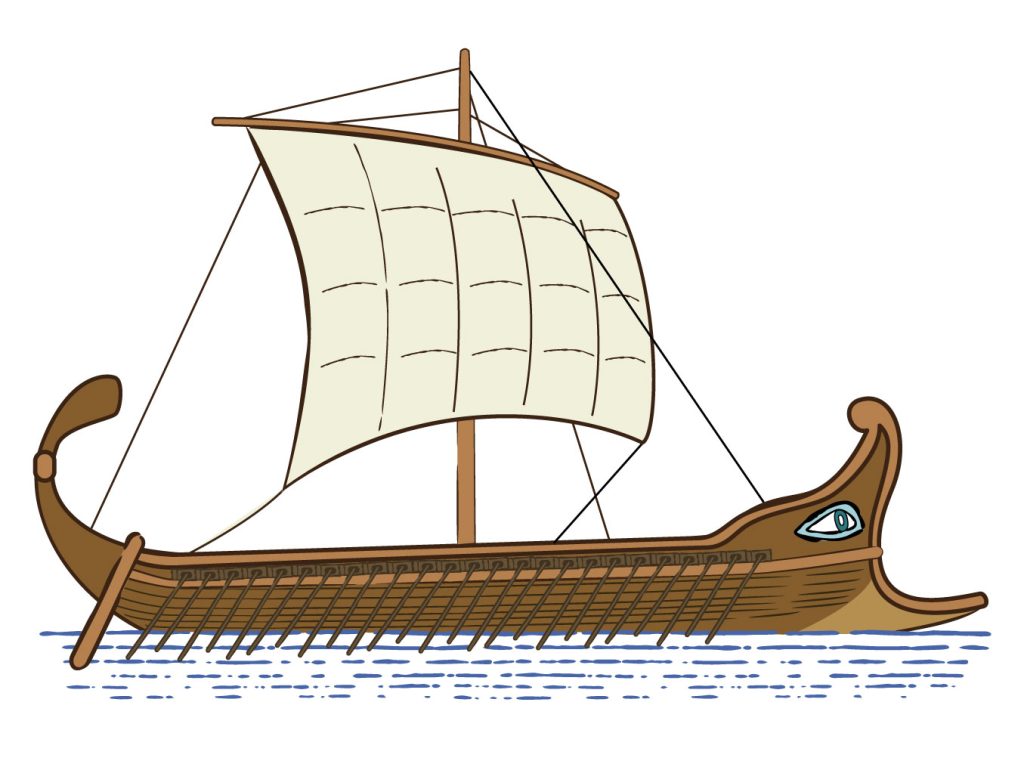
The Penteconter dates back to the Trojan era around 1500 BC and were still in use at the founding of the Italian city of Rome in the 8th century BC. The penteconters appeared during a time when the lines between merchant vessels and warships were not distinctly drawn. The Penteconter can be called a nomoreme bireme comes from “mono-” meaning one and “-reme” meaning oar.
The penteconter was named for its defining feature of having fifty oars. It was equipped with 25 rowers on each side, all seated in a single row. These rowers worked on an uncovered or unfenced deck, leaving them vulnerable to both weather elements and enemy attacks. Ancient Greeks also used the triaconter or triacontor (τριακόντορος triakontoros), a shorter version of the penteconter with thirty oars, and Homer mentions a boat of twenty oars. Additionally, the Boeotian ships were even larger, manned by as many as 120 men.
Constructed primarily from pine wood, the hull of these fifty-oared ships was often reinforced with animal skins to enhance water-tightness. Oars were made from polished spruce and the mast from spruce, was slotted into a box fitted to the keel of the ship. They were steered by one or two stern oars. The ships in the Odyssey were often described as black which probably referred to the tarring of the hull.
The penteconter also featured a rectangular sail, allowing it to navigate without solely relying on oars. The mast and sail were taken down when going into battle.
From the Bronze Age a large stone tied to a rope, could be used to anchor the boat. from the 6th century BC a new ‘admiralty’, hooked anchor was introduced. Wherever possible ships would be dragged up the beach stern first and propped up with stones or poles.
Initially, the penteconter’s ram was made of wood. However, as naval combat evolved and experience was gained, a bronze spearhead was eventually added to the ram’s foremost point, significantly enhancing its offensive capability.
Penteconters are believed to have been between 28m and 33m long, approximately 4m wide.
Evidence for the Penteconter
The writings of Homer
Homer depict warships with varying numbers of oars, ranging from smaller vessels with twenty oars, like the one used to return Chryseis to her father, to larger ships such as Odysseus’, which carried fifty-seven men.
Atreus launched a swift ship on the sea, and chose for it twenty rowers
Homer, Iliad, Book 1, lines 312-344
Coins from Tennes, the king of Sidon, around 351/0 BC
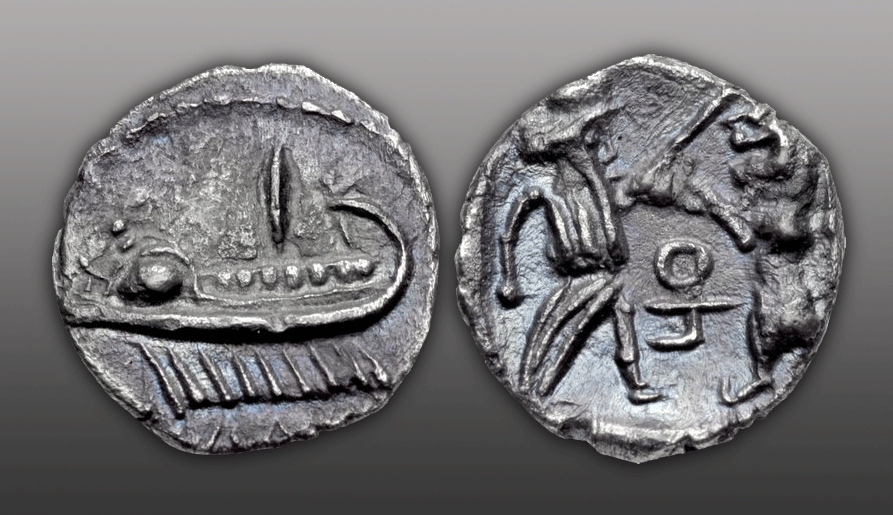
The above coin minted during the reign of Tennes, the king of Sidon, around 351/0 BC. The coin features an image of a Phoenician pentekonter sailing to the left, with waves depicted beneath it. The date of minting is indicated above the ship, though it appears faintly. On the other side, the coin shows the King of Persia standing to the right, gripping a lion by its mane.
Greek Vases
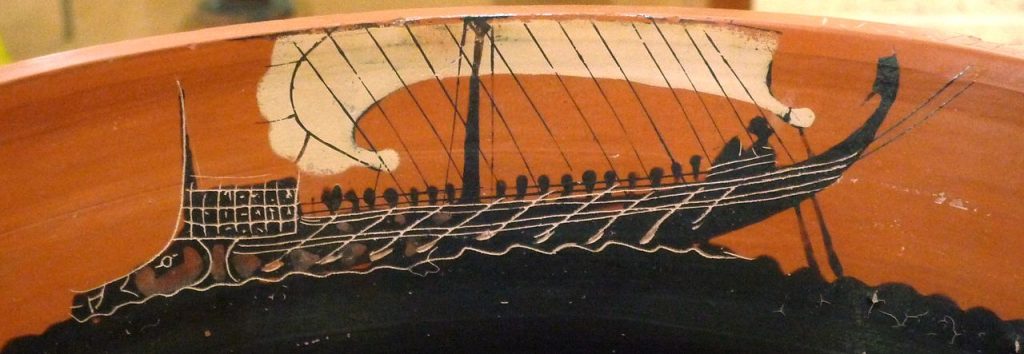
The above vase was found in the cemetery of Ancient Thera. Dated to the 3rd quarter of the 6th cent.
Mosaics
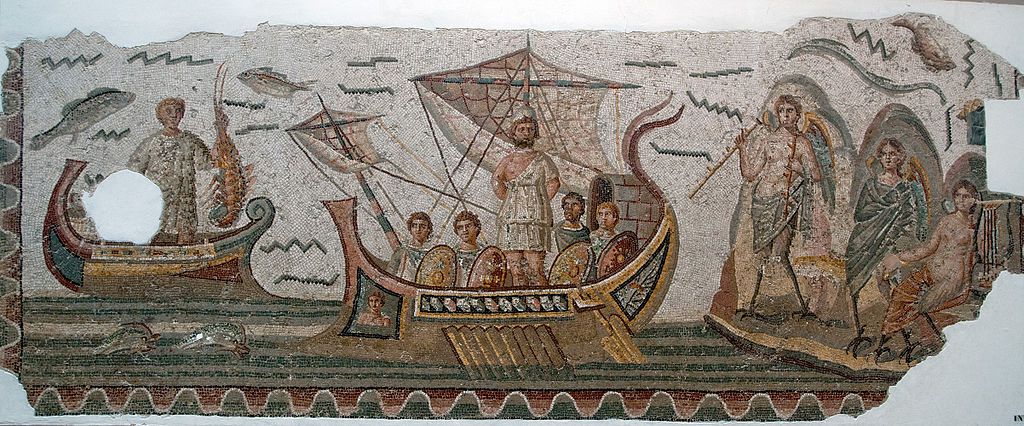
Ulysses tied to the mast, detail of 3rd century mosaic from Thugga, now in Bardo Museum, Tunis, Tunisia
Roman Bireme
From the late 8th century the bireme was invented. The name bireme comes from “bi-” meaning two and “-reme” meaning oar. It was typically about 24 m long with a maximum beam width of around 3 m. This galley was developed by the Phoenicians and later adopted by the Greeks and Romans. It had a better propulsion system than the pentecontore. This improvement involved using a “apostis”, a type of outrigger or beam projecting from the side of the ship, to which the oar was attached. The lower row worked just as in the penteconter: The rowers were sitting towards the centre of the ship, and the oars fulcrum was fixed on the rail. The rowers on the upper bench were sitting more to the outside (so they didn’t interfere with the other row) and, to get a decent lever, their oars were fixed on the outrigger. Approximately 100 rowers were used, 25 per side in each of the two rows.
Constructed primarily of oak, historical writings mention occasional adornment with golden sculptures, always featuring a rostrum (or spur) and a small tent known as La Diacta, serving as the precursor to the “carosse,” providing shelter for the captain, known as the Magister Navis, akin to a trierarch in Greek. Due to the narrow gangway between rowers, troop capacity on these light galleys (with one man per oar) was limited, thereby reducing their military effectiveness.
Phoenician Biremes (700-692 BC)
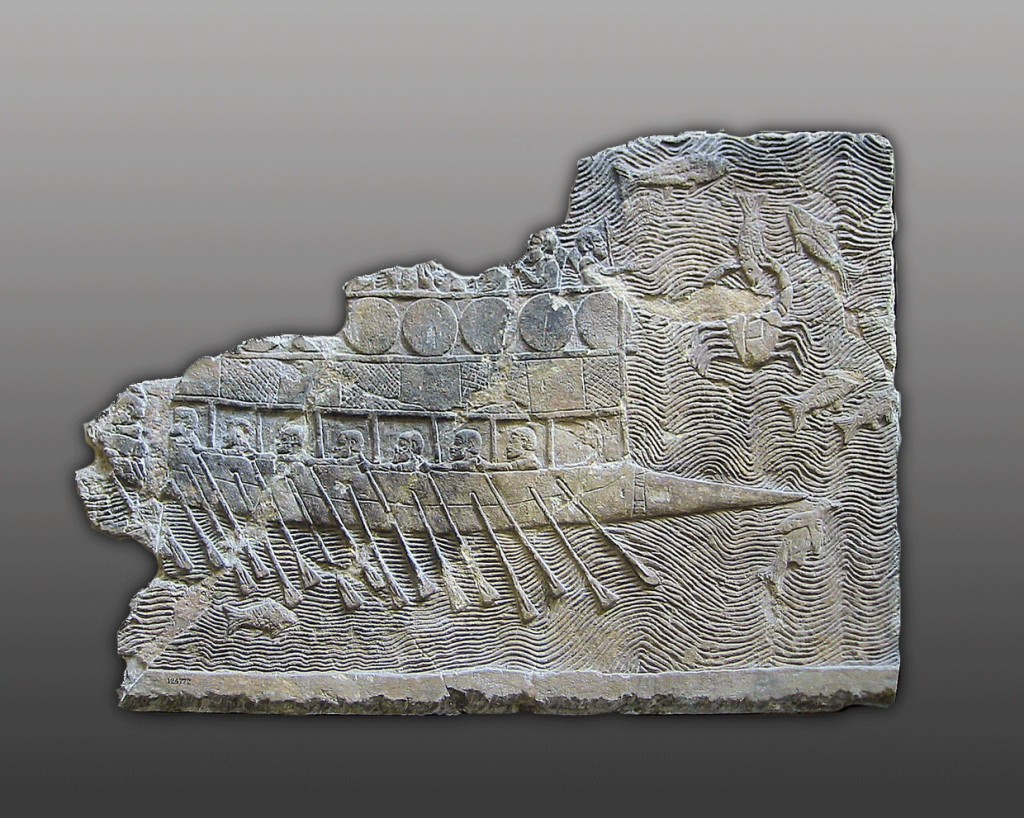
This Phoenician warship was depicted by Assyrians in their palace of Niniveh. It is a bireme, with two levels of oars. Shields are fastened around the superstructure, as on the fortifications of some city walls. The pointed bow is either a ram, for holding enemy ships, or a form of cutwater. Dated to 700-692 BC.
Roman Biremes (c. 120 BC)
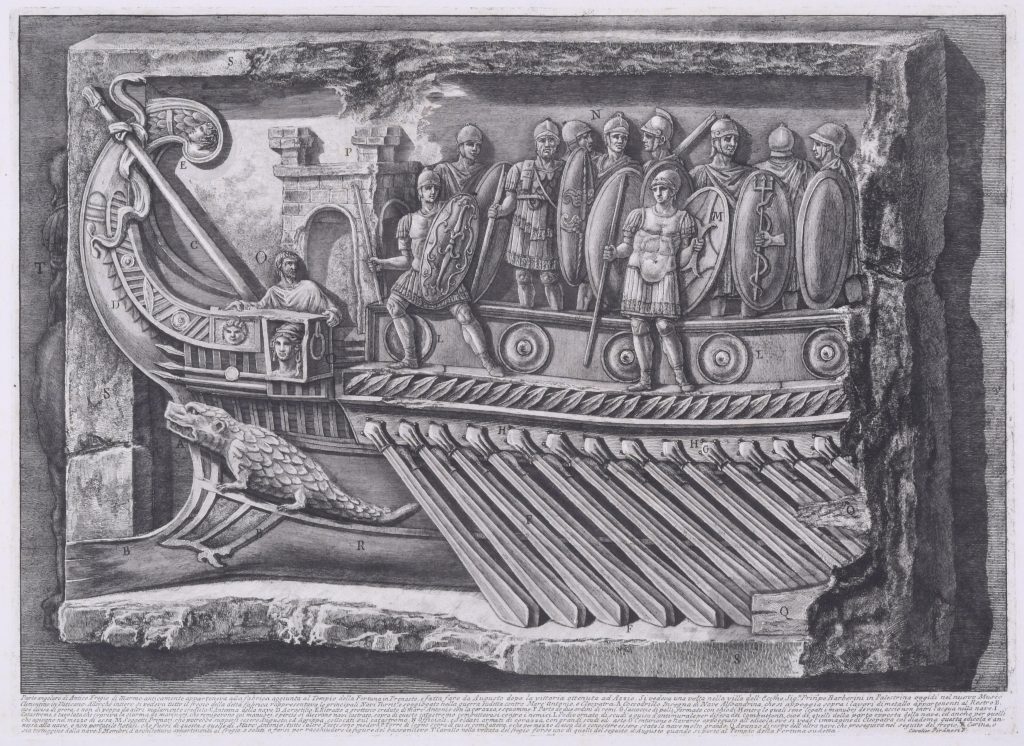
A drawing by Giovanni Battista Piranesi (1720-1778) of a Roman naval bireme depicted in a relief from the Temple of Fortuna Primigenia in Praeneste (Palastrina), which was built c. 120 BC; exhibited in the Pius-Clementine Museum in the Vatican Museums.
Bireme on Trajan’s Column (105BC and 106BC)
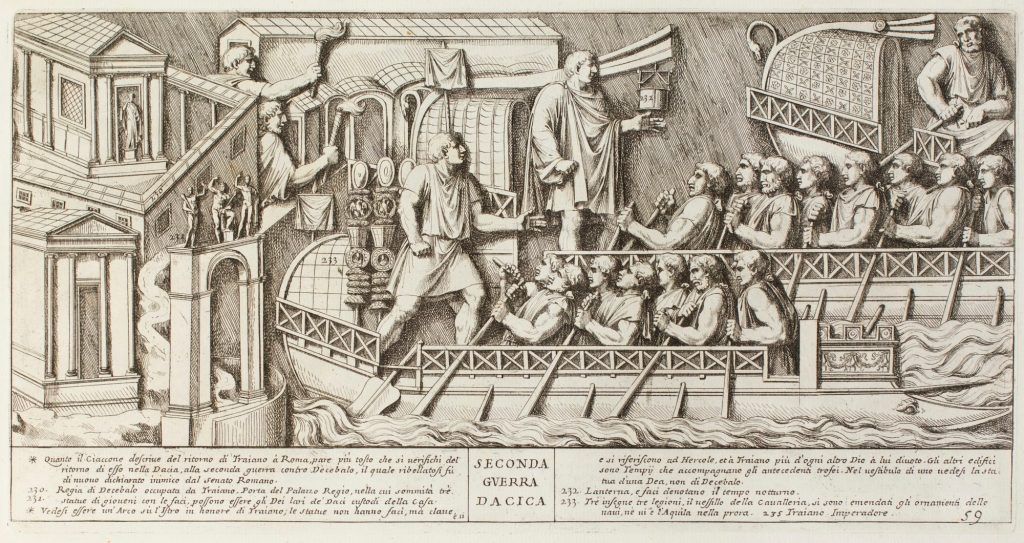
Liburna (bireme)
The Liburna (or Liburnica) gained renown as a vessel originating from the Liburnian pirates in the 7th century BC, renowned for their lightweight craft. Initially, the liburna bore resemblance to the ancient Greek penteconter. It featured a single row of 25 oars on each side. However, during the late Roman Republic, it had two tiers of oars (making it a bireme) and widened to allow two rowers per oar, which allowed it to maintain its speed, agility, and lighter construction compared to the heavier triremes.
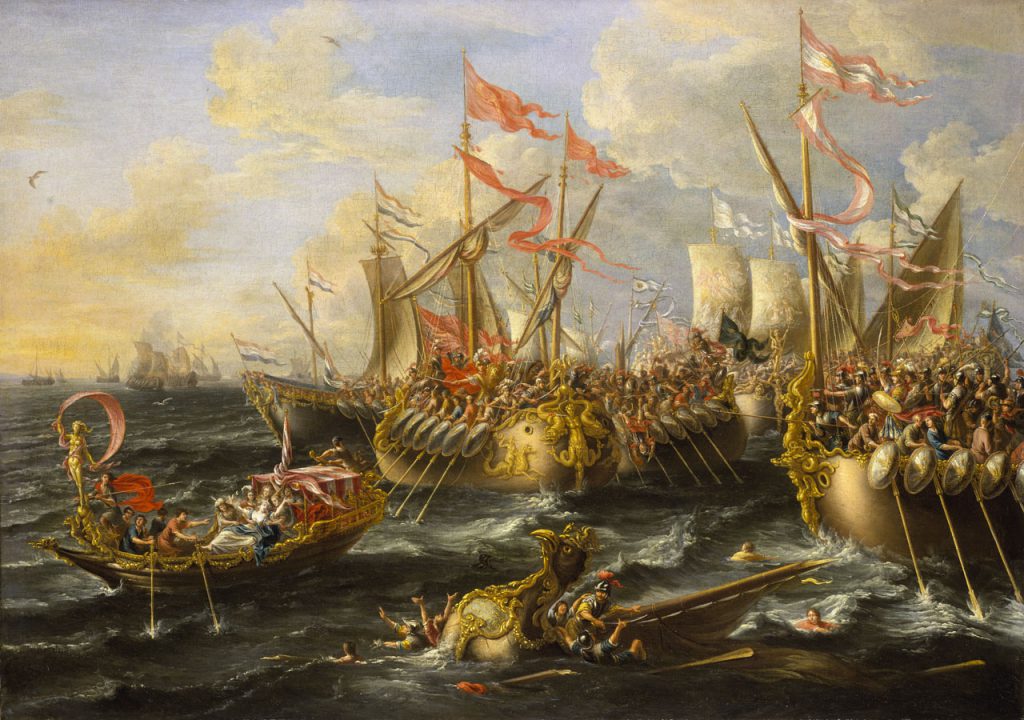
At the Battle of Actium in 31 BC, Agrippa’s Liburna played a pivotal role in encircling the formidable vessels of Marc Antony and Cleopatra’s fleet. Notable Roman modifications to the Liburna included an archer or command tower at the bow, a spacious open bridge accommodating two rowers, and combat-ready lateral bridges along with a high corvus.
Roman Trireme
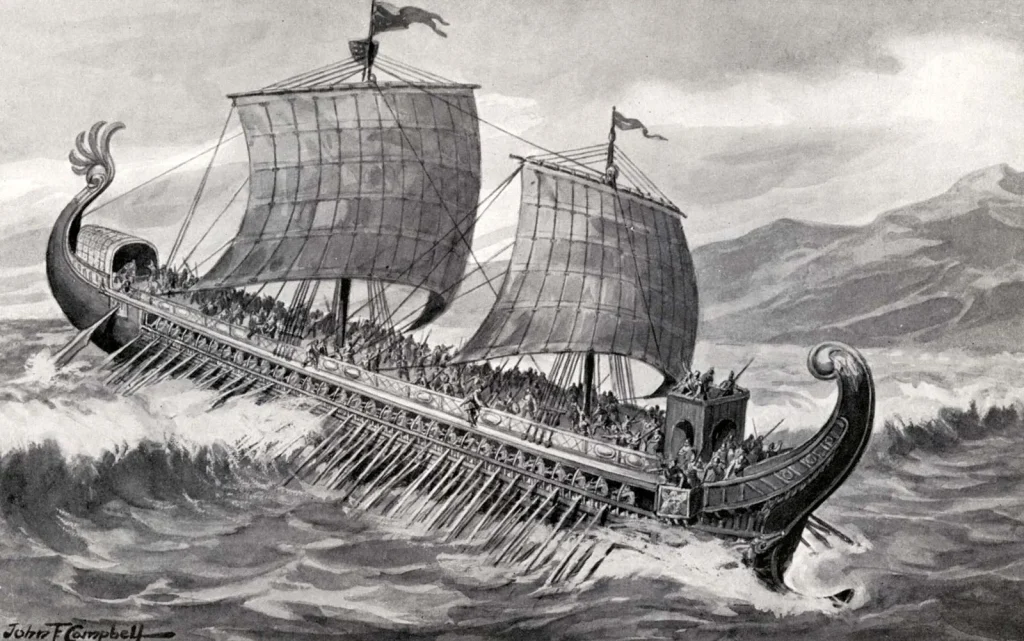
Once the idea of having multiple sets of rowers was established it was only a small step to progress to the trireme. According to Thukydides, the first triremes were build around 650 B.C. Around 500 B.C. the trireme was the standard heavy warship for most Greek city states.
For the trireme the outrigger was a more integral part of the ship then for the older bireme. It basically was a wide rowing frame, sitting on the still very narrow hull. Now the two upper rows of oars were fixed to the outrigger, the lower one passed through the side of the hull proper. The ship also had a (partial) fighting deck above the rowers (later versions probably had a full deck). If viewed from the bow this gave the ship the appearance similar to a two or three storey Tudor house.
The length of a trireme has been given as 35 meters, the beam as 3.5 meters (due to the outrigger the dimensions could be smaller than for the penteconter, and the ship could still pack more punch). The tonnage of the trireme has been estimated at approximately 40 metric tons (one third of which would be due to the 170 rowers). The top speed is usually estimated at 11.5 knots, although there are some speculations about ancient galleys actually entering the glide phase, which would defeat most of the wave resistance and allow speeds of up to 18 or 20 knots for very short bursts (wave resistance is the major factor in determining the top speed for a floating hull of a given length). There is convincing historical evidence that at least on one occasion a trireme with a crack crew managed to maintain 9 knots for 24 hours.
Now, the speed of the trireme is only 20 percent higher than for the penteconter, although it had three times as many rowers. This is due to the fact that the wave resistance is growing exponentially with the speed of the ship. However, a trireme has other advantages. It was much more maneuverable then the penteconter. It could accelerate from standstill to half speed in 8 seconds,
and to top speed in approximately 30 seconds.
An interesting point is that the Greek trireme with 170 rowers was manned by only 14 to 20 marines. It had to rely on the ram – boarding manoeuvres were seldom performed. The trireme was probably the most formidable ship ever designed for fighting with a ram. However, it had a number of drawbacks. It required a carefully trained and large crew. A single rower who couldn’t maintain the stroke could cripple the ship for minutes. Therefore, only free men were used on triremes. If, in times of an emergency, slaves had to be used, they were freed before the combat. A whip or lash was not used (and wouldn’t have worked).
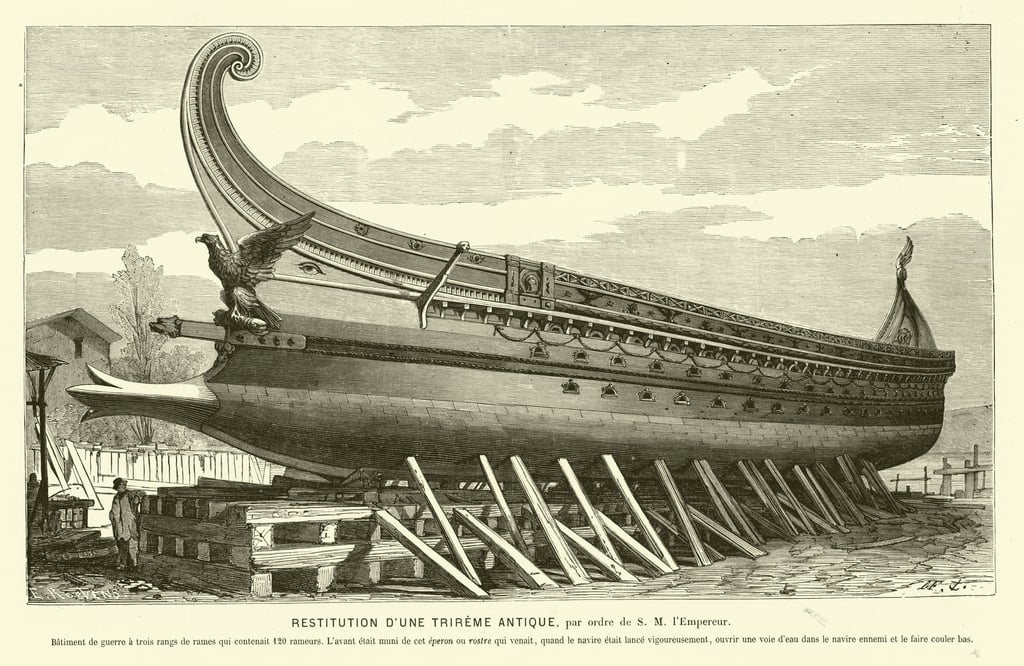
This traditional vessel epitomized classical naval prowess, securing Greek and particularly Athenian dominance in the Mediterranean for centuries until innovations by Rhodes introduced the tetra around 300 BCE.
The Roman designation of this ship as the Trireme likely emerged with the establishment of a distinctly Roman fleet, not through the borrowing of Greek vessels from cities like Tarentum or Messina. The earliest true Roman triremes were reportedly constructed in response to the Carthaginian threat during the First Punic War (261 BCE), coinciding with the development of the famous quinqueremes. These ships were promptly adapted to Roman military standards, prioritizing close combat where infantry superiority made the decisive impact, diverging from Greek tactics which favoured ramming manoeuvres. Consequently, the Trireme exhibited greater mass and dimensions compared to its Greek counterparts, which could be easily beached.
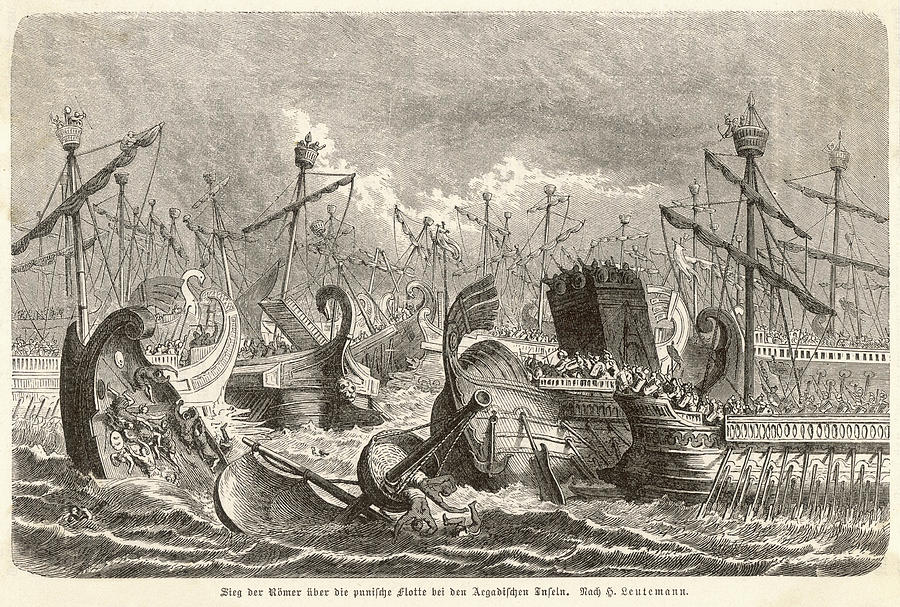
Equipped with a full deck providing ample space for fighters, the Trireme possibly housed projectile weapons such as ballistae. While the bronze rostrum retained its design for ramming, it soon became more of an ornamental extension of the hull, losing its military function.
Features of a Trireme
Standard features included the Diacta (a small awning for officers at the stern), an archer’s tower, possibly introduced by Agrippa on Roman ships according to contentious sources, two permanently rigged masts with sails never removed for combat. The mainsail sometimes featured decorative elements like a supparum, while the bowsprit sail bore the vessel’s name and captain’s insignia. The mainsail often displayed motifs symbolizing the Republic, adorned with spread eagle wings on laurels, occasionally embellished with lightning or symmetrical designs, and the inscription “SPQR” (Senatus Populusque Romanus). The legion’s standard was located aft, integrated into the shield of the stern figure.
Since the First Punic War, these ships were equipped with “ravens,” collision bridges used in quadriremes and quinqueremes. Despite its enduring utility owing to its manageable size and modest cost compared to larger vessels, triremes proved less effective against piracy compared to smaller units like liburnae. Nonetheless, triremes participated in all major naval engagements involving the Romans and remained in service until a relatively late date, around 400 CE, when they were replaced by larger galleys with multiple banks of oars. The term “trireme” persisted, denoting a moner with three rowers per oar, influencing the design of some Byzantine ships.
Roman Quadriremis
The naval campaigns during the initial stages of the First Punic War proved pivotal for the success of Roman military endeavours. Despite facing setbacks, including the loss of two fleets attributed to unfavourable weather conditions believed to be influenced by divine displeasure, Roman naval forces were swiftly assembled. Contrary to the prevailing notion of adopting vessels modelled after Greek designs or replicating captured Carthaginian ships in large quantities, Rome had long maintained smaller fleets through arrangements with cities like Taranto or Syracuse. Even before 200 BCE, the Romans had begun implementing vessels such as Pentekonters, Biremes, and Triremes. However, the turning point came when the new Greek standard, the “Tetris” or “4,” successfully developed by Rhodes and later adopted by the Carthaginians, gained prominence. Notably, the Romans embraced this new type of construction, scarcely larger than the Trireme but offering superior manoeuvrability. Legend has it that the Romans acquired a Rhodian Tetris, serving as a swift vessel in the Carthaginian fleet, and swiftly replicated it enmasse, producing the first Roman fleet consisting of approximately 200 vessels.
The utilization of two masts offered several advantages: facilitating the integration of two medium sails more effectively than a single large one and enabling easier mast folding during manoeuvres. It remains uncertain whether, like the Greeks, the Romans consistently deployed masts and sails during battle. Furthermore, astute observers would note that with two rows of oars, this galley functioned as a bireme. Typically, a Tetris adhered to a standard configuration consisting of two thranites (upper rowers), one zygite (middle rower), and only one thalamite (lower rower) per shell, operating three oars in three rows similar to the Trireme, or alternatively, two Zygites and two Thalamites managing two rows of oars. It’s now assumed that vessels designated as “4” or “5” and beyond accommodated a maximum of three rows of oars. However, nothing precluded the construction of a bireme with additional rowers, such as three Zygites and two Thalamites per lane, as seen in Greek Hepteras. Nevertheless, most depictions, including bas-reliefs and rare precise mosaics, suggest the use of “cataphract ships” with three rows of apostis (i.e., oars).
Pliny the Elder reports that Aristotle ascribed the invention of the quadrireme to the Carthaginians (Pliny, Natural History, VII.207).
Titus Livius mentions quinquereme and quadrireme being in use during the Second Punic War (218 to 201 BC).
When the Romans received information of what was going on they at once broke their camp at Leontini and marched to Syracuse. Some envoys had been sent by Appius to pass through the harbour on board a quinquereme, and a quadrireme which had sailed in advance of them was captured, the envoys themselves making their escape with great difficulty.
Titus Livius (Livy), The History of Rome, Book 24. 33
Roman Quinquereme
Quinqueremes, meaning “five-oared” and indicating that there were five oarsmen per bank of oars. The quinquereme stands out as the most renowned warship of the Hellenistic period, largely due to its widespread deployment by both the Carthaginians and the Romans. This vessel was conceived by Dionysius I, the tyrant of Syracuse, in 399 BC.
Scorpions and catapults are prominently displayed throughout the vessel. Instead of shields fixed to the railings, a genuine bulwark adorned with intricately sculpted pseudo shields is observed. A notable feature on precise bas-reliefs, this quinquereme boasts a figurehead known as the anti-rostrum, paying homage to the African campaigns led by the legendary Scipio, albeit lacking the traditional painted eyes. The symbolic significance of guiding the ship in uncertain waters with these eyes seems to have faded amidst the pragmatic concerns of the Roman military. This marks the advent of the “modern” prow, a design later adopted by the Byzantines featuring a lion’s head with a flame-throwing siphon.
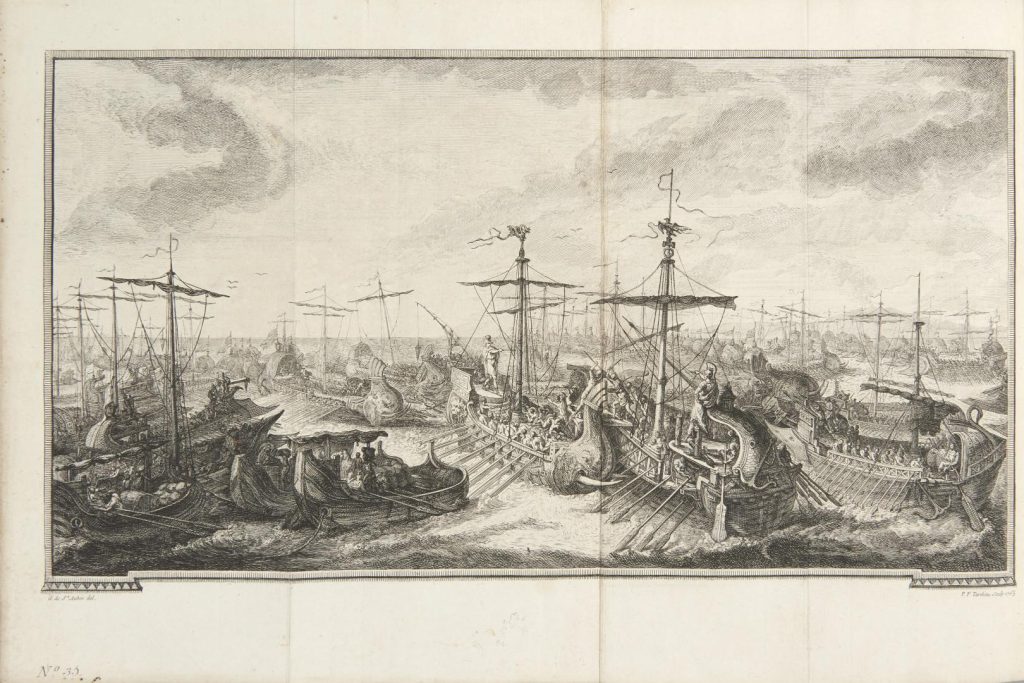
In contrast, ancient Greeks and Egyptians fashioned their rostra in animal forms before the instrument standardized as a weapon. The ramming function gradually waned on Roman ships following the demise of the last major Hellenistic fleet, that of the Lagids. The rigging incorporates the best elements of the time, including a mainsail with a supparum atop, a rudimentary forestay sail, and a bowsprit sail for manoeuvring, essential for handling these massive cedar-constructed vessels. The bowsprit mast was a common feature across penteconters, triremes, and other classical galleys. Measuring approximately 58 meters in length and 7 meters in width, this quinquereme nearly matches the dimensions of a decree (ranging between 60 and 80 meters). Despite the challenging configuration of two oars per rower, these formidable ships remained relatively sluggish, relying on their projectile weapons and embarked troops (here approximately 130, a fraction of a cohort) for superiority.
Rowing aboard these galleys was undoubtedly an arduous and undesirable task, yet conscripts found solace in the pay it offered, escaping the hardships of poverty. Typically composed of three zygites and two thalamites per side, rowers may have been positioned standing. Beneath the rowing compartment, enclosed and likely suffocating, was a hold tall enough for a man to stand upright. Ballast in the form of stones or lead, along with ample water supplies stored in stretched leather water skins and jars filled with preserved meat and fruits, sustained the Roman fleets during prolonged expeditions, particularly punitive cruises targeting piracy during the imperial era. Rigging became increasingly vital, primarily serving to alleviate the strain on rowers, whose endurance was tested primarily during combat manoeuvres. It’s widely accepted that masts were never taken down.
While the Greek trireme boasted sufficient ventilation and lightness to dry quickly, the reinforced Roman trireme with a full deck was considerably heavier yet lacked propulsive power. The addition of one or two extra rowers per side seemed to address this issue. Quinqueremes were procured from nearby Greek cities, replicated, and modified, subsequently deployed en masse during the initial stages of the First Punic War. The pragmatic Romans adapted this new standard, developed by Greek cities and major Hellenistic empires, including the Macedonians, Lagids, and Seleucids, as well as the Carthaginians, known as the Pentery, primarily to counter lighter Carthaginian vessels. Despite being more costly to construct and maneuvering less swiftly, quinqueremes possessed a formidable arsenal of ballistae, scorpions, and catapults, primarily aimed at disabling the oars of opposing galleys while accommodating a larger contingent of troops, including the renowned heavy Roman infantry. This infantry, distinctively trained and adapted for naval warfare unlike their Carthaginian counterparts influenced by Greek epibates, provided the Romans with a numerical advantage in superior troops. Moreover, the Romans capitalized on their expertise in employing archers from towers and projectile weaponry, in addition to the towering stature of their vessels and the famed “corvus,” a swinging bridge employed for easy boarding, as described by Polybius.
Decereme
The Roman Fleet traditionally comprised four main types of units, with the smallest being specialized vessels known as “naval dust,” alongside the light Romanized Triconteres, Diconteres, and Pentaconteres utilized for liaison and reconnaissance purposes. Serving as shock units were the Biremes, Triremes, and Quadriremes, with the Quinqueremes, notably heavy, also deployed in significant numbers, almost akin to ships of the line. Referred to as “aphraktoi” in the Greek sense, these vessels featured a full deck ready to accommodate ample troops and siege engines, functioning as isolated heavy units. Octeres and Deceres (Romanized as “Deciremus,” for instance) were comparatively rare and scarcely mentioned. The latter boasted ten rowers for each section in principle, likely distributed across three rows—four on top, three in the middle, and three below.
The concept of four-row superimposed units seems implausible due to the vessel’s height. Alternatively, it’s feasible that there were only two rows of oars, albeit widely spaced, manned by 6 Thranites and 4 Zygites. According to accounts, Mark Antony’s flagship Decere at Actium boasted a freeboard twice as high as a trireme, roughly exceeding six meters. The Romans were not fond of classic naval tactics like the Diekplous, which relied on speed and agility for ramming maneuvers. Instead, they employed ad hoc tactics that maximized the utilization of infantry. For instance, at Actium, they utilized small Liburnae, Illyrian pirate ships, to encircle their opponents and initiate infantry combat. Consequently, following the adoption of Hemioliae and Liburnae, Quinqueremes and higher-class vessels were primarily relegated to command roles in Imperial Rome, before ultimately being phased out altogether. This transition occurred as the Mediterranean came under Roman control, leading to a significant reduction in piracy, notably since Pompey’s campaign.
Navis lusoria
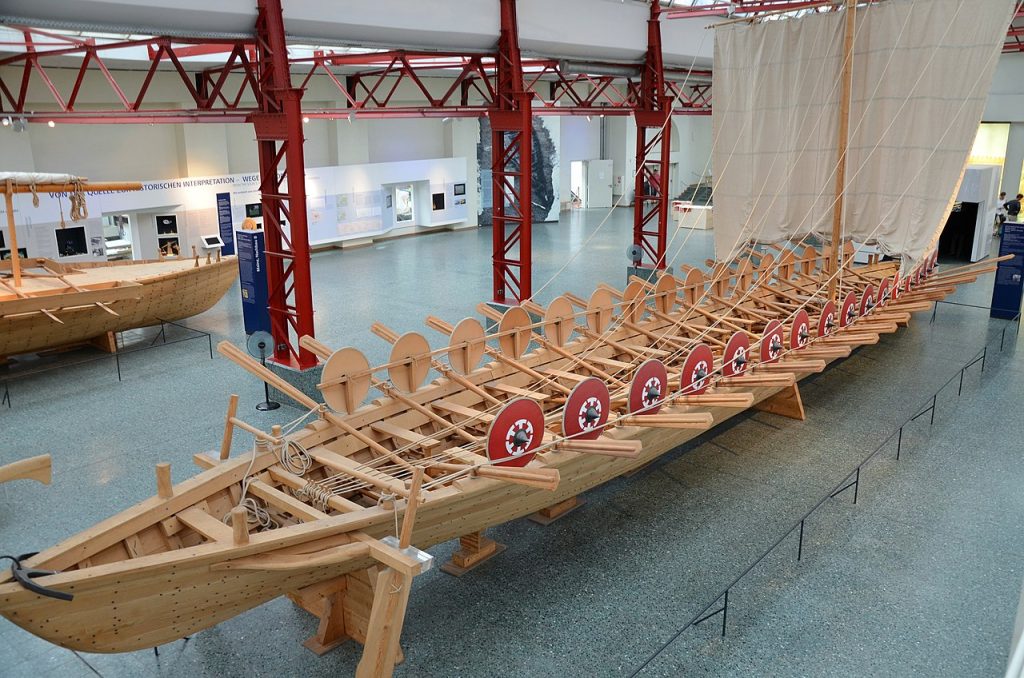
The navis lusoria was a compact military ship from the late Roman Empire, utilized for transporting troops. About thirty soldier-oarsmen powered it, supplemented by a sail. Known for its agility, elegance, and shallow draft, this type of vessel operated primarily in the rivers of the northern regions adjacent to the Limes Germanicus, the frontier of the Roman-controlled Germanic territories. Consequently, it was a common sight on the Rhine and Danube rivers. The existence of the navis lusoria is noted in the historical accounts of Roman historian Ammianus Marcellinus; however, a comprehensive understanding of these ships only emerged with the discovery of similar vessels in Mainz, Germany, between 1981 and 1982.
Merchant vessels
Rome heavily depended on shipping for its substantial grain consumption. Annually, the city imported around 150,000 tons of grain from Egypt during the first three centuries AD. This was because the agricultural areas near Rome couldn’t provide enough grain, and sea transportation was more cost-effective than land routes. For instance, it was cheaper to transport grain by a Roman sailing ship across the entire Mediterranean than to move it just 15 miles overland.
For military needs, such as during the Second Punic War, merchant vessels like the naves onerariae were frequently requisitioned. A notable example occurred in 204 BCE when Scipio Africanus commandeered merchant ships for his invasion of Africa. According to the historian Livy, he seized four hundred ships for this purpose.
One of the most exact inventories of Roman commercial boats, the Althiburus mosaic, is a superb example of scientific, nautical expertise. It was discovered in a Roman villa near the ancient city of Althiburus, which is present-day Tunisia, in the third century AD. The mosaic features 25 mosaics of boats.
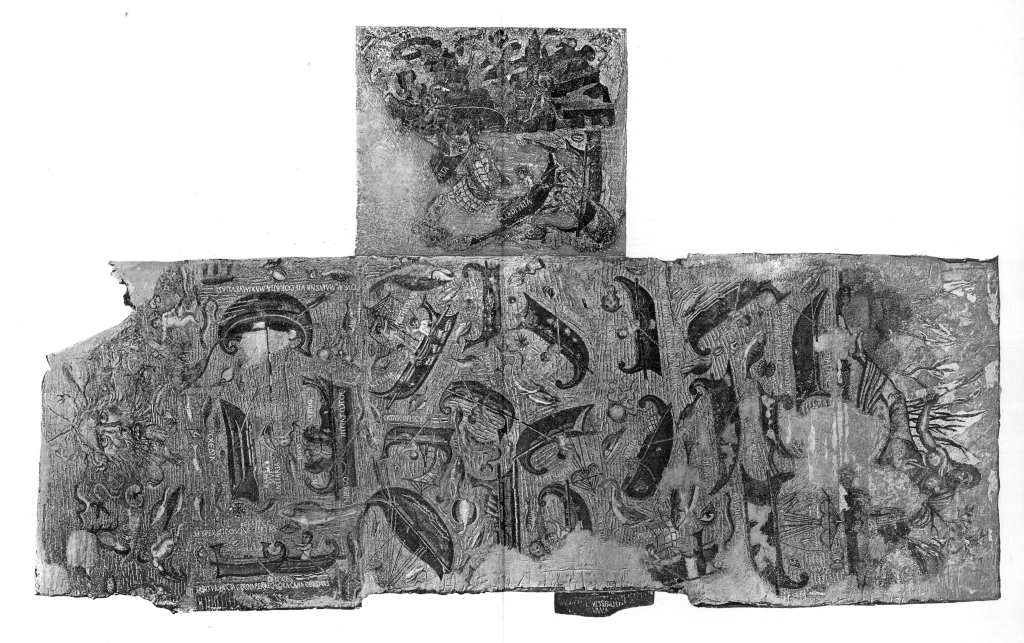
Althiburus mosaic
Navis Oneraria
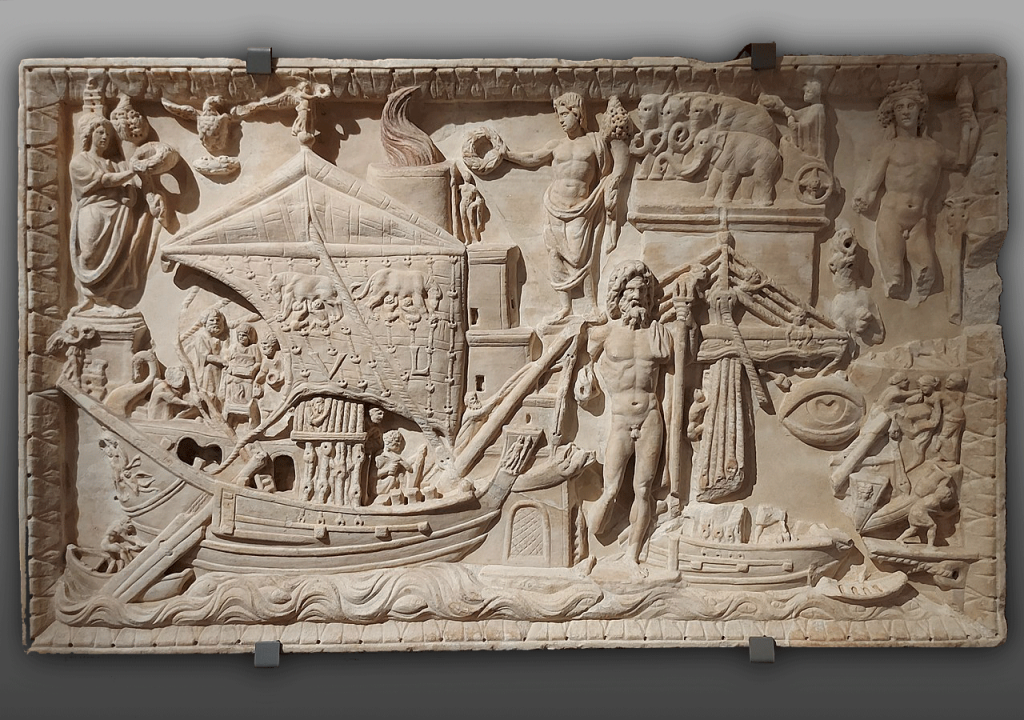
Torlonia Marbles – Rome
The Oneraria, recognized long before the imperial era as the quintessential Roman cargo vesse. These high-capacity ships, capable of accommodating over 3000 amphorae, evolved from the Greek cataphract cargo vessels that facilitated trade among the Hellenistic empires across the Mediterranean. They bore distinct Roman features, including the absence of a rear ladder and a sturdy hull designed for deep-sea voyages, indicative of the emergence of modern ports with jetties. Additionally, they featured a quarter-deck terrace often sheltered by an awning, a superstructure for the bridge, and a distinctive gooseneck stern figure.
These vessels were substantial in size, occasionally featuring double decks with two superposed bridges, equipped with a bowsprit for manoeuvrability, and relying primarily on a mainsail for propulsion, rendering them adept not only in coastal navigation but also in open-sea voyages. Constructed from solid oak, they were capable of enduring the rigors of the sea, navigating by the stars during nighttime passages. With the advent of the imperial era, the Romans gained access to vast forests in Gaul and Germany, enabling the construction of larger freighters. An Imperial Oneraria typically measured 35 meters in length and nearly 10 meters in width, with a crew comprising no more than 10 versatile individuals.
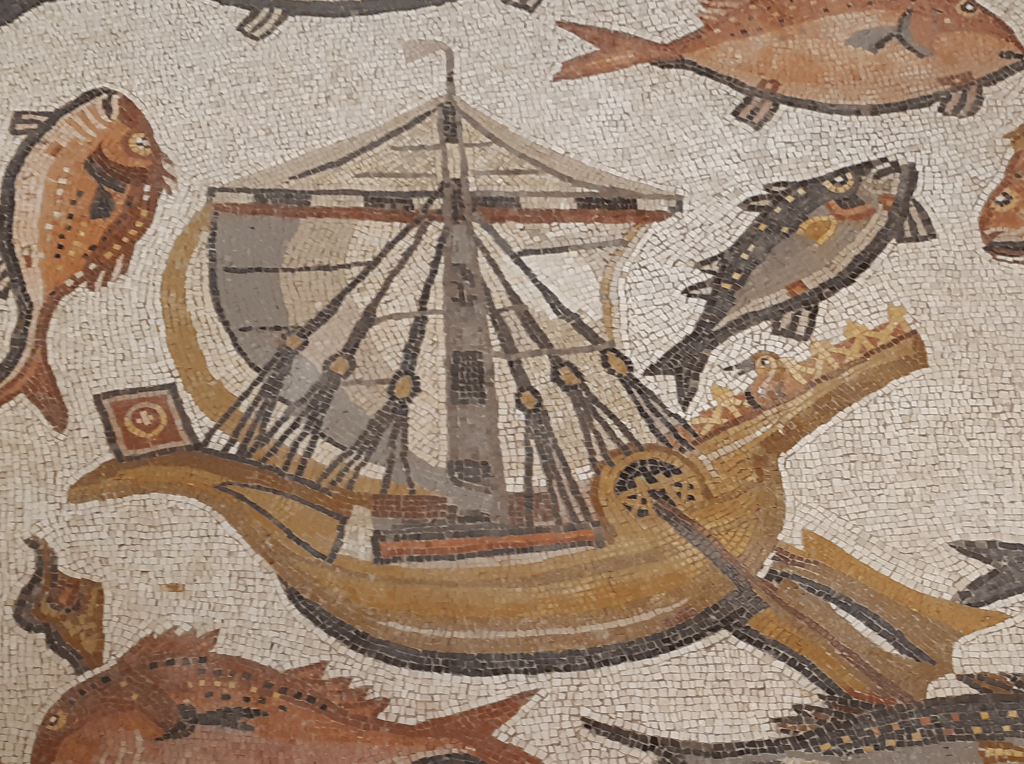
Oneraria from Lod Mosaic, Israel
Corbita
While documentation may be scarce for Roman cargo ships compared to other vessel types, these ships are better known due to the enormity of their cargo, often responsible for their shipwrecks—a fate uncommon for war galleys, which were considered unsinkable. Greek and Roman cargo ships litter the depths of the Mediterranean, buried beneath layers of well-preserved amphorae. Despite the challenges posed by the extreme antiquity of these wrecks and the deteriorated state of their wooden structures, archaeologist divers can piece together their basic configurations by cross-referencing them with bas-reliefs and frescoes spanning centuries.
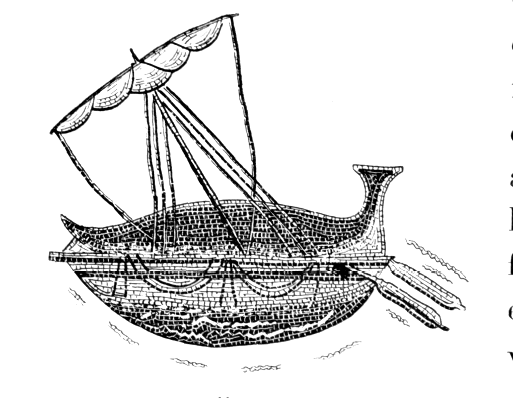
The Corbita featured a stitched sail and an interrupted rail to facilitate loading. The Roman iteration represented the pinnacle of this design, boasting a significantly larger hull. To aid manoeuvrability, it was equipped with a sail known as the “artemon,” an ancestor of the bowsprit jib. The mainsail was often adorned with a distinctive triangular arrow-shaped sail called the Supparum, typically in red. Among these cargo ships, the Onerariae stood out as true behemoths of their time, measuring over 55 meters in length, 13 meters from keel to tillac, and 14 meters in width. Capable of carrying up to 2000 tons of cargo, equivalent to around 40,000 amphorae, they primarily transported wheat from Sicily. Typically traveling in convoys protected by the fleet to ward off pirate attacks, these Roman cargo ships could also accommodate up to 400 passengers under Spartan conditions. Lacking space for rowers, their navigation was slow, often hugging the coastlines as they made their way back from Alexandria or Sicily to ports such as Ostia.
Navis Actuaria
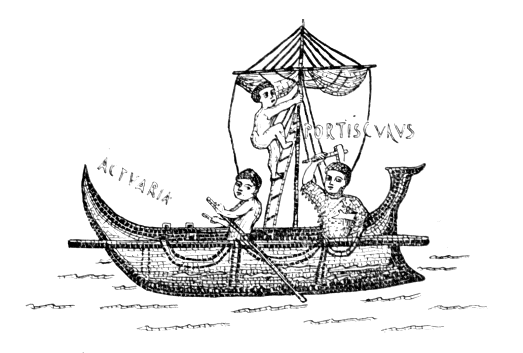
One of the earliest ships of the Roman Republic was a light galley featuring a single row of oars with 24 rowers, utilized for dispatching alongside larger units. Following the Greek typology, there were Cisocontores (20 rowers, 10 per side), and Triacontores (30 rowers, 15 per board), as well as various intermediate variants. These vessels, known as Actuariae, were lightweight and typically housed no fewer than 18 rowers, making them easily manoeuvrable both at sea and on shore.
Faster than the massive Onerariae, these ships were primarily intended for coastal shipping or short routes. Occasionally, very small units, with less than 10 rowers per rowing, were also accommodated on the octaves or decades of flags, facilitating connections to land or other ships, such as during Antony’s actions at Actium, where he left the battle using such a ship called Scapha, akin to the Yawls seen on later sail ships.
Different models of the actuaria served as transport vessels for soldiers, notably during the invasion of Britain. In 47 BCE, Publius Vatinius outfitted actuariae with provisional rams at Brindisi to aid Julius Caesar’s army in Illyricum, across the Adriatic Sea, although these ships were only capable of engaging with smaller enemy crafts. Additionally, around 16 AD, Germanicus utilized actuariae on significant rivers during his military operations against the Germanic tribes.
Common Terms
Fenced: This term describes a ship that is fully decked, offering protection from the elements with a covered area for both people and cargo below the decks.
Unfenced: Refers to a ship that either lacks a full deck or has no deck at all, typically featuring a central walkway along its keel with rowing benches on either side. The Viking longship is a well-known example of this type.
Beaching: This process was typically used when port facilities were unavailable. It involved rowing the ship towards the shore at a moderate pace, retracting the oars as the beach neared. Non-rowing crew members and marines would move to the ship’s rear, lifting the front and allowing the vessel to smoothly reach the shore. The ship would then be secured and gangplanks lowered for disembarkation. Beaching was rarely done under sail to avoid damaging the rigging, and timing it between tides was crucial to prevent stranding the ship.
The Corvus: Also known as the Crow, this device was akin to a drawbridge. It featured a ramp with handrails and a spike resembling a beak. Mounted on a short mast at the ship’s front, it was operated with pulleys and could be swiveled over an enemy’s deck and dropped to pierce it, allowing boarding. However, the Corvus made ships unstable in rough seas, leading to capsizing incidents.
A description of the Corvus was written by Polybius in his Histories:
Now their ships were badly fitted out and not easy to manage, and so some one suggested to them as likely to serve their turn in a fight the construction of what were afterwards called “crows.” Their mechanism was this. A round pole was placed in the prow, about twenty-four feet high, and with a diameter of four palms. The pole itself had a pulley on the top, and a gangway made with cross planks nailed together, four feet wide and thirty-six feet long, was made to swing round it. Now the hole in the gangway was oval shaped, and went round the pole twelve feet from one end of the gangway, which had also a wooden railing running down each side of it to the height of a man’s knee. At the extremity of this gangway was fastened an iron spike like a miller’s pestle, sharpened at its lower end and fitted with a ring at its upper end. The whole thing looked like the machines for braising corn. To this ring the rope was fastened with which, when the ships collided, they hauled up the “crows,” by means of the pulley at the top of the pole, and dropped them down upon the deck of the enemy’s ship, sometimes over the prow, sometimes swinging them round when the ships collided broadsides. And as soon as the “crows” were fixed in the planks of the decks and grappled the ships together, if the ships were alongside of each other, the men leaped on board anywhere along the side, but if they were prow to prow, they used the “crow” itself for boarding, and advanced over it two abreast. The first two protected their front by holding up before them their shields, while those who came after them secured their sides by placing the rims of their shields upon the top of the railing. Such were the preparations which they made; and having completed them they watched an opportunity of engaging at sea.
Polybius, Histories, Book 1 Chapter 22
The Harpago: Similar to a grappling hook, this device resembled a harpoon and was launched by catapult. Once it embedded in an enemy ship, the attached rope was pulled to draw the vessels together for boarding. The Harpago, also serving as shipboard artillery, eventually replaced the Corvus due to its greater efficiency.
The Rostra: The primary offensive weapon of ships was the ram, or rostra, a large protrusion at water level, often metal-clad, designed to breach enemy hulls. The challenge lay in withdrawing the ram swiftly to avoid being dragged down by a sinking enemy ship or breaking the ram, often leading to intense combat.
The Balistae: This weapon resembled a giant crossbow, but instead of a bow, it used levers as torsion springs powered by tightly wound rope or sinew. It launched stone projectiles, large arrows, bolts, and incendiary missiles at enemy ships.
